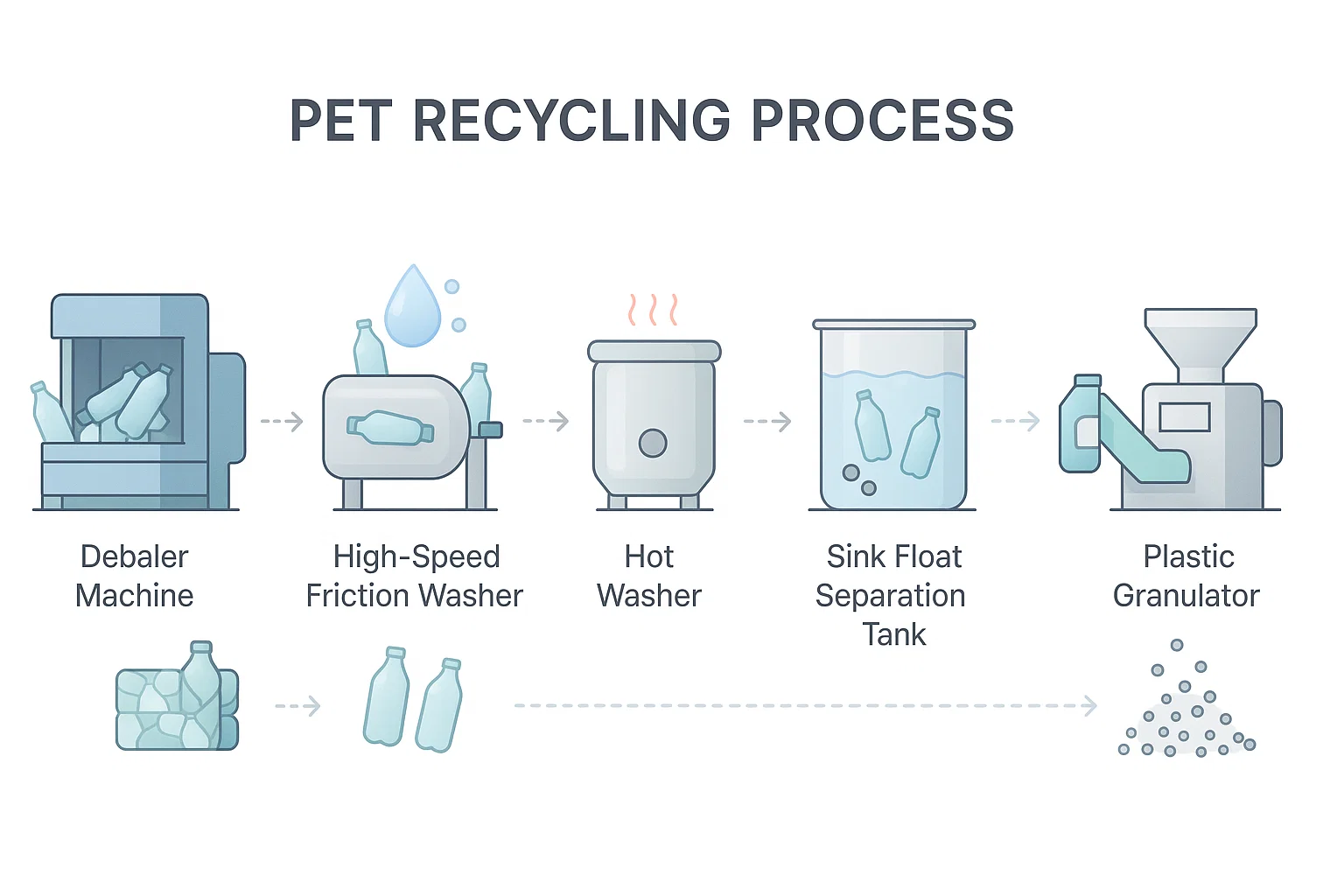À medida que as indústrias se comprometem cada vez mais com práticas sustentáveis, Máquinas de reciclagem de PET surgiram como ferramentas essenciais no combate ao desperdício de plástico. Esses sistemas avançados não apenas incorporam a responsabilidade ambiental, mas também representam uma mudança crucial em direção à recuperação eficiente e em larga escala do plástico.
Neste guia, exploramos o componentes principais de uma linha de reciclagem de PET, destacando a tecnologia e os processos que permitem a transformação de resíduos de PET pós-consumo em materiais valiosos e reutilizáveis.
O que é uma máquina de reciclagem de PET?
PET (Polietileno Tereftalato) As máquinas de reciclagem são projetadas para processar garrafas e recipientes plásticos usados, convertendo-os em flocos ou pellets de PET de alta qualidade. Esses produtos reciclados podem ser reaproveitados em têxteis, embalagens de qualidade alimentar e produtos industriais, contribuindo diretamente para um economia circular.
Um sistema completo de reciclagem de PET normalmente inclui diversas máquinas especializadas, cada uma projetada para desempenhar uma função específica com a máxima eficiência. Vamos examiná-las em sequência.
1. Máquina desfardadeira – Iniciando o Processo de Reciclagem
O processo de reciclagem começa com a máquina desfardadeira, que separa fardos densamente compactados de garrafas PET recebidas de centros de coleta. Esta máquina separa as garrafas e as alimenta na linha para inspeção e triagem individual.
Por que isso é importante: Sem a desbalagem adequada, os equipamentos a jusante podem travar ou operar de forma ineficiente. Esta máquina garante fluxo e rendimento consistentes desde o começo.
2. Lavadora de fricção de alta velocidade – Limpeza Intensiva de Superfícies
Em seguida, as garrafas passam por uma limpeza mecânica no arruela de fricção de alta velocidade. Girando em alta velocidade, ele esfrega as superfícies de PET para remover rótulos, resíduos de cola, vestígios de alimentos e sujeira.
Principal benefício: O atrito de alta velocidade garante que os flocos de PET sejam completamente limpos, melhorando pureza gerale desempenho a jusante.
3. Lavadora quente – Esterilização e Descontaminação Profunda
O lavadora de água quente leva o processo de limpeza um passo adiante, expondo flocos de PET a água quente misturada com detergente. Isso esteriliza o plástico e remove contaminantes à base de óleo, adesivos e materiais orgânicos.
Propósito: Para garantir que os flocos se encontrem padrões de higiene, especialmente para aplicações que exigem PET reciclado de qualidade alimentar (rPET).
4. Tanque de separação de pia-flutuação – Classificação de materiais baseada em densidade
Usando o princípio de separação de densidadeO tanque de flutuação e afundamento isola os flocos de PET de materiais mais pesados, como tampas (geralmente de PEAD) e contaminantes estranhos. Os flocos de PET flutuam, enquanto as impurezas mais densas afundam.
Resultado: Esta etapa melhora significativamente pureza do material, apoiando maiores taxas de recuperação e qualidade de saída consistente.
5. Separador de Etiquetas – Remoção precisa de contaminantes residuais
Apesar da limpeza inicial, algumas etiquetas e adesivos podem persistir. separador de rótulos atinge esses materiais não-PET por meio de métodos mecânicos e baseados em ar.
Visão de engenharia: Esta etapa garante que apenas flocos de PET limpos cheguem à granulação final, atendendo padrões de qualidade industrial para reprocessamento.
6. Peletizador de plástico – Transformando Flocos em Pellets Reutilizáveis
Por fim, os flocos de PET limpos e separados são alimentados na plástico peletizador, que os tritura em grânulos ou pellets uniformes. Estes podem ser usados diretamente em moldagem por injeção, extrusão, ou produção de fibras.
Impacto na indústria: Isso completa o ciclo de reciclagem, fornecendo matérias-primas de alta qualidade para fabricação de novos produtos à base de PET.
Perguntas Frequentes (FAQs)
Quais materiais uma máquina de reciclagem de PET pode manusear?
As linhas de reciclagem de PET são projetadas especificamente para tereftalato de polietileno Garrafas e recipientes (PET), normalmente dos setores de bebidas, alimentos e bens de consumo.
Como uma máquina desfardadeira melhora a eficiência da reciclagem?
Ao quebrar fardos de PET compactados, o desfardador garante alimentação e classificação suaves, evitando bloqueios mecânicos e permitindo maior rendimento de processamento.
Por que uma lavadora quente é importante para a qualidade do PET reciclado?
Ele remove contaminantes biológicos e químicos, tornando os flocos adequados para aplicações de alta qualidade ou de qualidade alimentar, dependendo das especificações do sistema.
Qual é o objetivo do processo de separação por afundamento e flutuação?
Ele separa o PET de materiais com densidades diferentes, como tampas e rótulos, garantindo assim uma produto final de maior pureza.
Como o separador de etiquetas mantém os padrões de saída?
Elimina resíduos componentes não-PET, garantindo que apenas flocos não contaminados sejam convertidos em pellets, o que melhora o valor de mercado do reciclado.
O que acontece com os flocos de PET após a granulação?
Eles se transformam em grânulos ou pellets de PET, prontos para reutilização em nova produção de garrafas, fibras têxteis, ou aplicações de engenharia.
Conclusão: Tecnologia de Reciclagem de PET para um Futuro Industrial Sustentável
Máquinas de reciclagem de PET estão no coração de estratégias modernas de gestão de resíduosCada componente — do desbaleamento à granulação — desempenha um papel vital no fornecimento de materiais PET limpos e reutilizáveis que podem reingressar na cadeia de suprimentos. Para profissionais de compras e engenheiros, investir em uma linha de reciclagem de PET de alta eficiência significa não apenas conformidade ambiental mas também recuperação de recursos com boa relação custo-benefício.
À medida que as tecnologias continuam a evoluir, empresas como Energia estão comprometidos em fornecer soluções de reciclagem de ponta que capacitem as indústrias a minimizar o desperdício e maximizar o valor.



